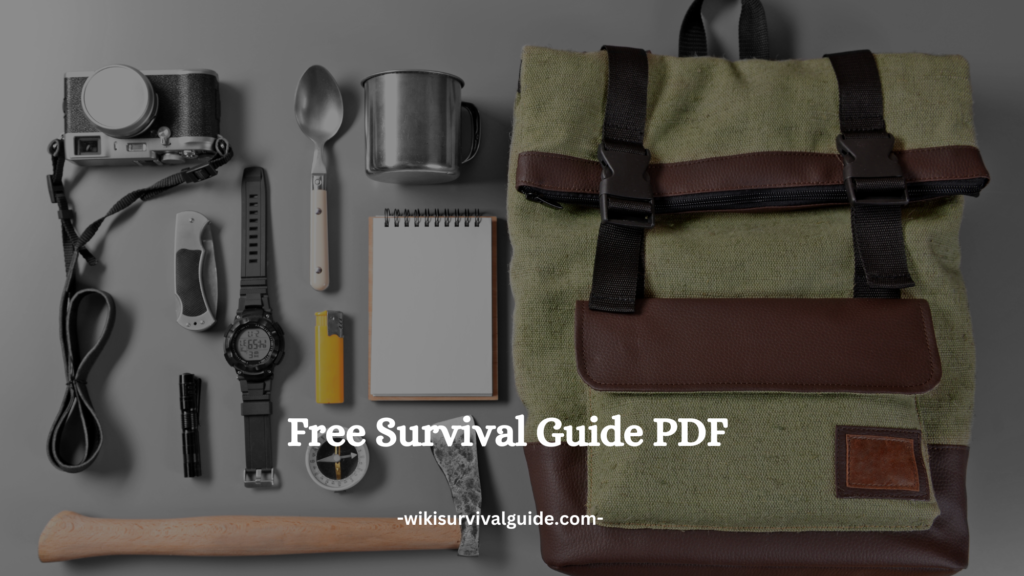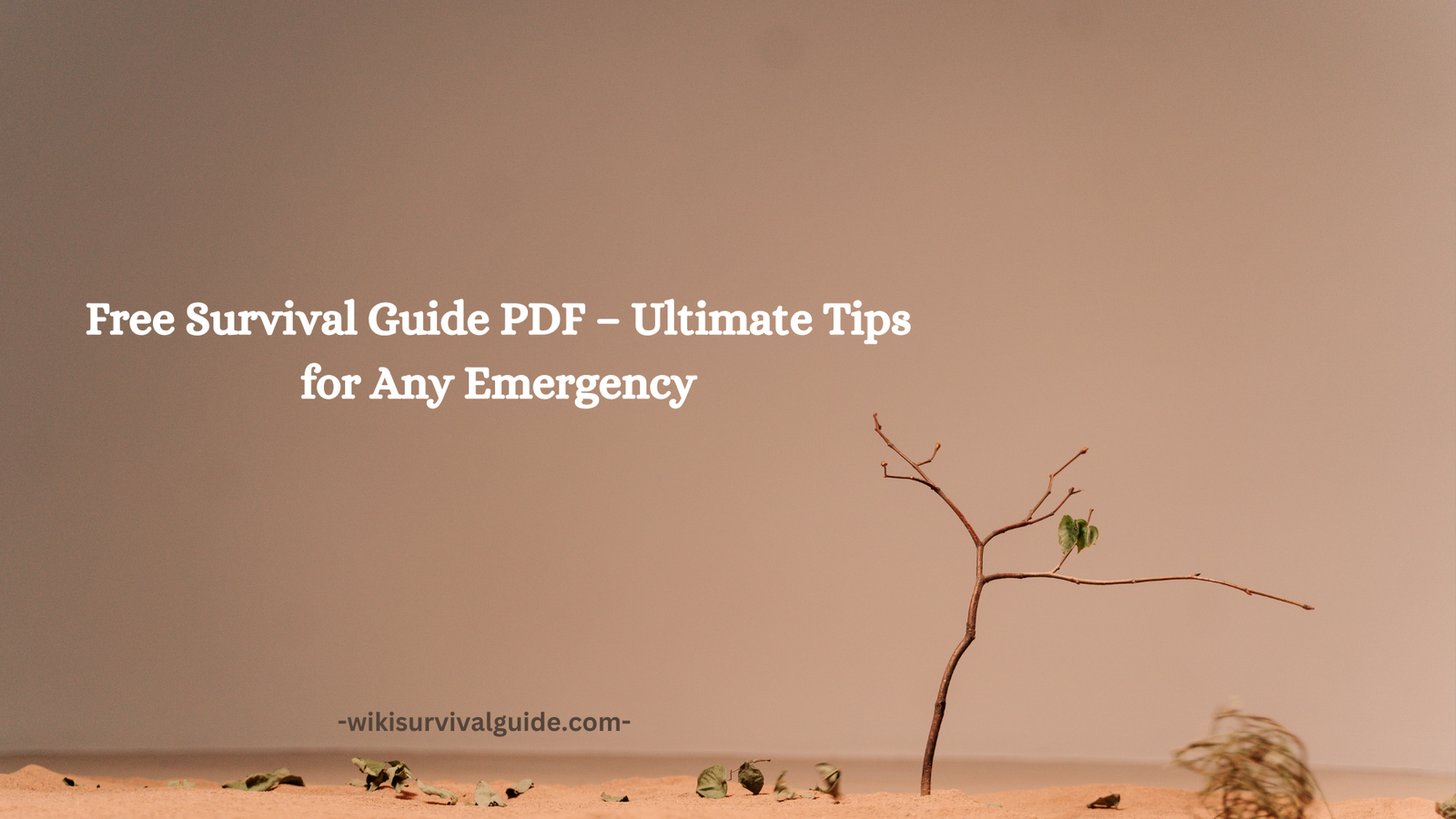Survival is all about being prepared for the unexpected. Whether you’re facing a natural disaster, power outage, economic crisis, or an outdoor survival situation, having a Survival Guide PDF at your fingertips can be a lifesaver. This guide will cover essential survival skills, must-have gear, emergency preparedness tips, and long-term survival strategies to help you stay safe in any situation.
With a free downloadable Survival Guide PDF, you’ll have instant access to critical survival knowledge that could mean the difference between life and death.

Survival Essentials Checklist
A well-prepared survival checklist ensures you have everything needed to withstand emergencies, whether in the wild or during a disaster.
Essential Gear:
- Multi-tool with knife, pliers, and screwdriver
- Fire-starting kit (waterproof matches, lighter, ferro rod)
- First-aid kit with bandages, antiseptic, and painkillers
- Compact flashlight with extra batteries
- Emergency whistle and signal mirror
Food & Water:
- Portable water filter or purification tablets
- High-calorie emergency food bars
- Freeze-dried meals with a compact stove
- Lightweight metal pot for boiling water
- Reusable water bottles and collapsible containers
Shelter & Clothing:
- All-weather emergency bivvy or sleeping bag
- Tarp and paracord for building makeshift shelters
- Insulated and waterproof clothing layers
- Extra socks and gloves for warmth
Navigation & Communication:
- Topographic map and compass
- Hand-crank or solar-powered radio
- Fully charged power bank for devices
- Notepad and waterproof pen for recording locations
Being prepared with these essentials increases your chances of survival in any situation.
Emergency Preparedness Basics
Survival is about planning ahead and knowing how to respond in crises.
Creating a Survival Plan:
- Identify evacuation routes for home, work, and school
- Establish emergency contact points for family communication
- Prepare a 72-hour survival bag for each family member
Basic Survival Skills:
- Fire-starting in wet conditions
- First aid techniques for cuts, burns, and fractures
- Navigating without GPS using the sun and stars
Stockpiling Emergency Supplies:
- Store non-perishable food and water for at least two weeks
- Keep cash in small denominations for emergencies
- Have a backup power source like a generator or solar charger
Preparation is key to surviving disasters, ensuring safety and resilience.
How to Find and Purify Water
Water is the most critical survival resource, and knowing how to locate and purify it is essential.
Finding Water in the Wild:
- Look for flowing water sources like rivers and streams
- Dig near dried-up riverbeds for underground moisture
- Collect rainwater using tarps or large leaves
Purification Methods:
- Boiling: Kills bacteria and viruses; let water cool before drinking
- Filtration: Use a portable filter or create a DIY sand and charcoal filter
- Chemical Treatment: Use purification tablets or bleach (2 drops per liter)
Water Storage Tips:
- Keep stored water in BPA-free containers away from direct sunlight
- Rotate stored water every six months for freshness
- Carry multiple purification options for backup
Access to clean water is crucial for hydration, cooking, and sanitation in survival situations.
Food Storage and Preservation Tips
Proper food storage extends shelf life and prevents spoilage, ensuring you have enough supplies during emergencies.
Best Foods for Long-Term Storage:
- Canned goods (beans, meats, vegetables)
- Dried foods (rice, pasta, lentils)
- Freeze-dried meals and MREs (Meals Ready to Eat)
- Nuts, seeds, and dried fruits for quick energy
Food Preservation Methods:
- Dehydration: Removes moisture from fruits, vegetables, and meats
- Canning: Seals food in jars to prevent bacteria growth
- Vacuum Sealing: Reduces exposure to air and moisture
- Root Cellaring: Natural storage method using underground temperature control
Stockpile Management:
- Rotate food supplies using the First In, First Out (FIFO) method
- Label and date all stored food
- Store food in cool, dark, and dry places to prevent spoilage
A well-maintained food stockpile provides security and nutrition in survival scenarios.
Mental Preparedness for Survival Situations
Survival is as much a mental battle as it is a physical one. Panic and fear are natural reactions to emergencies, but managing them effectively can mean the difference between life and death. Developing a strong survival mindset involves practicing calm decision-making under pressure, maintaining a positive outlook, and adapting to new challenges quickly. Mental resilience is built through exposure to stress, training, and visualization techniques. Confidence in one’s survival skills, combined with problem-solving abilities, ensures a steady approach to adversity. Practicing mindfulness, breathing exercises, and mental rehearsals of survival scenarios can help maintain focus and prevent emotional breakdowns in high-stress situations.
Best Free Survival Guide PDFs to Download
Access to high-quality survival information can be crucial in emergency situations. Many organizations and experts offer free survival guide PDFs that cover essential topics such as wilderness survival, urban preparedness, food preservation, and self-defense. These guides provide step-by-step instructions on fire-starting techniques, water purification, first aid, and shelter-building strategies. Having a collection of survival guides stored on a waterproof USB drive or printed in a durable, weather-resistant format ensures quick access to vital knowledge when the internet is unavailable. Websites like FEMA, the Red Cross, and dedicated survival communities often provide reliable and practical resources for survivalists at all experience levels.
Common Survival Mistakes to Avoid
One of the biggest survival mistakes is failing to plan adequately. Many people underestimate the importance of preparation and neglect critical aspects like water sourcing, fire-starting techniques, and navigation skills. Another common mistake is wasting energy—overexertion can lead to exhaustion and dehydration, making survival even harder. Ignoring the body’s signals, such as thirst and fatigue, can lead to life-threatening conditions. Consuming unknown plants without proper knowledge can result in poisoning, while building shelters in unsafe locations, such as near unstable cliffs or dry riverbeds, increases risk. Survivors must also avoid over-relying on gear; skills and adaptability are far more valuable than any single tool.
DIY Survival Hacks and Tricks
Simple yet effective DIY survival hacks can significantly increase chances of survival in an emergency. Creating a makeshift water filter using charcoal, sand, and a plastic bottle can purify water in the wild. Duct tape serves multiple purposes, from repairing gear to making splints for injuries. A soda can and chocolate can be used to polish the bottom of the can into a reflective fire-starting mirror. Cotton balls soaked in petroleum jelly make excellent fire starters, while a simple solar still can collect and purify water using condensation. Turning an empty can into a makeshift stove or a survival whistle out of a spent bullet casing are just a few of the many creative ways to use everyday items for survival.
How to Train for Survival Scenarios
Training for survival requires a combination of physical, mental, and tactical preparation. Building endurance and strength through regular exercise, hiking, and weight training improves physical capability in survival situations. Practicing essential skills such as fire-starting, knot-tying, and map reading helps develop confidence and proficiency. Simulating real-life survival scenarios, such as spending a night outdoors with minimal gear, enhances adaptability. Learning self-defense techniques ensures preparedness for dangerous encounters, while first aid training equips individuals to handle medical emergencies. Engaging in drills, such as bug-out simulations and escape-and-evasion exercises, helps refine instincts and decision-making in high-pressure environments.
Building a Survival Shelter
A reliable shelter protects against harsh weather, predators, and environmental hazards.
Choosing the Best Location:
- Avoid flood-prone areas and low valleys
- Look for natural windbreaks like rock formations or dense trees
- Ensure access to fresh water without being too close to wildlife trails
Types of Survival Shelters:
- Lean-To Shelter: Uses a sturdy branch and tarp or foliage for cover
- Debris Hut: Built with leaves, branches, and insulation for warmth
- A-Frame Shelter: Provides stability and protection in windy conditions
Essential Shelter-Building Tools:
- Paracord for securing branches and tarp
- Hatchet or saw for cutting wood
- Insulation materials like dry leaves or pine needles
A well-constructed shelter keeps you safe from the elements and increases survival chances.
Fire Starting Techniques for Any Environment
Mastering fire-starting techniques is crucial for survival in any setting. Fire provides warmth, light, cooking capabilities, and protection.
Fire-Starting Methods:
- Ferro Rod & Striker: Reliable in wet conditions and lasts thousands of strikes.
- Flint & Steel: Produces sparks when struck against steel, requiring dry tinder.
- Fire Bow Drill: Primitive friction method that generates heat through rotating wood.
- Chemical Fire Starters: Potassium permanganate and glycerin react to ignite a flame.
- Battery & Steel Wool: Touching steel wool to battery terminals creates ignition.
Best Tinder Options:
- Dry grass, birch bark, or shredded wood shavings
- Cotton balls soaked in petroleum jelly
- Char cloth for long-lasting embers
Fire in Harsh Conditions:
- Wet Environments: Use resin-rich fatwood or waterproof fire starters.
- Windy Areas: Build a windbreak using rocks or logs to shield the flame.
- Snow/Ice: Use an elevated fire platform made of logs or stones.
Having multiple fire-starting methods ensures preparedness for any survival scenario.
Essential First Aid Skills
Knowing first aid can save lives in emergencies, whether in the wilderness or urban environments.
Life-Saving First Aid Techniques:
- CPR & Rescue Breathing: Revives individuals in cardiac or respiratory distress.
- Stopping Bleeding: Apply direct pressure, elevate the wound, and use a tourniquet if necessary.
- Wound Cleaning & Dressing: Use antiseptic wipes and bandages to prevent infection.
- Fracture Splinting: Immobilize broken limbs using sticks and cloth.
- Shock Management: Keep the person warm, elevate legs, and provide reassurance.
Emergency First Aid Kit Must-Haves:
- Sterile bandages, gauze, and medical tape
- Antiseptic wipes, antibiotic ointment, and pain relievers
- Tweezers, scissors, and safety pins
- Emergency blanket and tourniquet
Quick and effective first aid response increases survival chances before professional help arrives.
Self-Defense and Personal Safety
Personal security is essential for survival, whether in urban settings or the wilderness.
Situational Awareness:
- Always scan your surroundings for threats.
- Trust your instincts and avoid risky situations.
- Stay in well-lit areas when navigating at night.
Basic Self-Defense Techniques:
- Escape Holds: Use leverage to break free from grabs.
- Strikes: Target vulnerable areas like eyes, throat, and groin.
- Improvised Weapons: Use everyday objects like keys, pens, or sticks for defense.
Self-Defense Tools:
- Pepper spray or personal alarm for non-lethal protection.
- Tactical flashlight with a strobe mode to disorient attackers.
- Survival knife or baton for last-resort defense.
Being prepared with self-defense skills increases confidence and safety in unpredictable situations.
Navigation Without GPS
In survival situations, GPS may not always be available. Learning natural navigation techniques ensures you stay on track.
Using the Sun for Navigation:
- The sun rises in the east and sets in the west.
- In the Northern Hemisphere, the sun is slightly south at noon.
Navigating with Stars:
- Locate the North Star (Polaris) to determine true north.
- In the Southern Hemisphere, the Southern Cross constellation points south.
Using a Map & Compass:
- Orient the map using landmarks and a compass.
- Learn how to take a bearing to navigate to your destination.
Signs in Nature:
- Tree Moss: Tends to grow on the north side in the Northern Hemisphere.
- Wind Patterns: Prevailing winds can indicate cardinal directions.
Developing navigation skills prevents disorientation and increases survival odds in unknown terrain.
Urban Survival Strategies
Urban environments present unique challenges, requiring different survival tactics.
Essential Urban Survival Skills:
- Blending In: Avoid looking like a target by dressing casually.
- Situational Awareness: Stay alert to your surroundings and avoid unsafe areas.
- Emergency Exits: Always have an escape route in crowded places.
Survival Kit for Urban Settings:
- Compact multi-tool for various tasks.
- Cash in small denominations for emergencies.
- Portable water filter and non-perishable snacks.
- Emergency radio and flashlight with extra batteries.
Finding Shelter in a City:
- Look for abandoned buildings or safe indoor areas.
- Avoid congested streets during mass panic situations.
Understanding urban survival strategies ensures safety and preparedness in city-based emergencies.
Wilderness Survival Tactics
Surviving in the wilderness requires adaptability, resourcefulness, and knowledge of essential survival skills. The first priority is securing shelter, as exposure to harsh weather can be life-threatening. Natural shelters like caves, fallen trees, or rock overhangs can provide immediate protection, while a lean-to or debris hut can be built for long-term use. Fire is another critical element, offering warmth, cooking capabilities, and protection from predators. Using a ferro rod, flint and steel, or friction-based methods like the bow drill ensures reliable fire-starting even in wet conditions.
Water is the next crucial resource. Flowing streams and collected rainwater are the safest sources, but purification is necessary to avoid illness. Boiling, using purification tablets, or a portable water filter can eliminate harmful pathogens. Food sources in the wild include edible plants, insects, and small game. Trapping, fishing, and foraging require proper knowledge to avoid poisonous plants or unsafe food sources. Navigation is also essential to avoid getting lost—natural indicators like the sun, stars, and tree moss can help determine direction when a compass is unavailable.
Must-Have Survival Gear
Carrying the right survival gear significantly increases the chances of survival in any environment. A sturdy fixed-blade knife is indispensable for cutting, hunting, and self-defense. A quality fire starter, such as a ferrocerium rod, ensures a consistent fire source. A lightweight tarp or emergency bivvy provides shelter, while a compact water filter guarantees access to clean drinking water. Paracord has countless uses, from setting traps to securing shelters. A multi-tool can serve various functions, including repairing gear and opening cans. A high-lumen flashlight with extra batteries is vital for night visibility, and a small first aid kit with bandages, antiseptics, and pain relievers is necessary for treating injuries.
Long-Term Survival Planning
Survival for extended periods requires a strategy for sustainability. Securing a reliable food and water source should be the primary focus. Building a long-term shelter using natural materials like wood, clay, and leaves ensures stability and insulation. Hunting and trapping techniques must be refined to provide a steady food supply, while foraging knowledge helps supplement meals with edible plants and fruits. Preserving food through drying, smoking, or salting extends its usability.
Defensive strategies are also important, especially in areas with predators or potential human threats. Crafting makeshift weapons, setting perimeter alarms, and maintaining a hidden shelter reduce risks. Mental resilience is just as critical as physical preparedness—staying motivated, managing stress, and avoiding panic can make the difference between survival and failure.
Bug-Out Bag Packing Guide
A bug-out bag should contain everything necessary to survive for at least 72 hours. Water storage and filtration options, including a durable water bottle and purification tablets, are essential. High-calorie, lightweight food such as protein bars, dehydrated meals, and nuts provide necessary energy. A durable survival knife, fire-starting tools, and a compact sleeping bag or bivvy ensure preparedness for harsh conditions.
Clothing layers suited to different weather conditions, including thermal socks and waterproof gear, help maintain body temperature. A first aid kit with bandages, antiseptic wipes, pain relievers, and any required personal medications is non-negotiable. Navigation tools such as a map, compass, and emergency whistle improve chances of finding safety. A compact survival radio provides important updates, and duct tape, safety pins, and zip ties offer versatile solutions for repairs and emergencies.
How to Signal for Help in an Emergency
Attracting attention in an emergency can mean the difference between life and death. Fire is one of the best signaling methods, as smoke can be seen from miles away. Three fires in a triangular pattern signal distress, while colored smoke or flashing lights further enhance visibility.
Mirrors and reflective surfaces can be used to send light signals toward aircraft or distant rescuers. Blowing a loud whistle in sets of three is a universally recognized distress signal, as is creating large SOS symbols using rocks, logs, or the ground itself. If stranded with a phone, activating the emergency SOS function sends alerts with location details. Flares, brightly colored clothing, and even shouting at regular intervals increase the chances of being found. Staying near open areas with high visibility and listening for rescue sounds improves survival odds.
Conclusion
Preparedness is not a one-time task—it’s a continuous process. Whether you’re an experienced survivalist or a beginner just starting your preparedness journey, having access to a Survival Guide PDF ensures you never get caught off guard.
Make sure to download and print your guide, practice the survival techniques inside, and stock up on essential gear. The more prepared you are, the better your chances of thriving in any emergency. Stay ready, stay safe, and keep learning new survival skills!
FAQs
1. Is the Survival Guide PDF really free?
Yes, this guide is 100% free to download and use for personal preparedness and emergency planning.
2. Can I print the Survival Guide PDF?
Absolutely! It’s recommended to keep a printed copy in your emergency kit in case digital devices fail.
3. What topics does this survival guide cover?
The guide includes wilderness survival, urban preparedness, first aid, self-defense, food and water sourcing, shelter building, and more.
4. How often should I update my survival knowledge?
Survival skills should be practiced and updated regularly, at least every few months. Staying informed about new survival techniques and gear is crucial.
5. Where can I find more free survival resources?
For advanced survival techniques, check out the Wilderness Long-Term Survival Guide PDF Free Download and the Extras Academy Survival Guide for expert survival strategies.




Leave a Comment